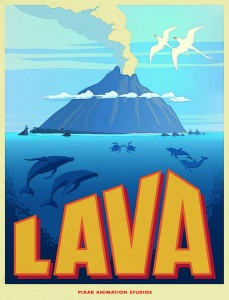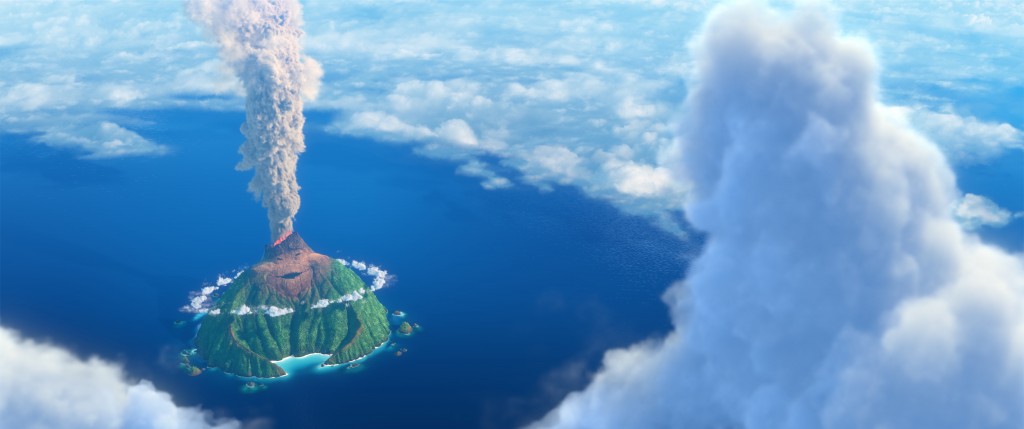THE BLACK SHEEP INTERVIEW: JAMES FORD MURPHY (LAVA)
An interview with LAVA director, James Ford Murphy
Last fall, amidst the flurry of films that is the Toronto International Film Festival, I managed to catch a tiny short film about a volcano that just wants to love and be loved in return. He sings his happy Hawaiian song day and night in hopes that someone out there hears it and finds him. As a single person who fights constantly against the cynicism that tries daily to overpower him, I found LAVA to be a beautiful ode to love and hope. And now, audiences everywhere will finally get to see this spectacular gem when it plays in theatres before the new Pixar film, INSIDE OUT.
Director, James Ford Murphy, who has worked as an animator at Pixar for nearly 20 years, and has worked on some of their biggest hits, including FINDING NEMO, THE INCREDIBLES and RATATOUILLE, now joins the ranks of famed Pixar directors like John Lassetter and Brad Bird with his first short film, LAVA. Murphy and I sat down at the Walt Disney offices here in Toronto to discuss how his little project came to be, how it pushed the people at Pixar forward and why he thinks Pixar puts out such consistently satisfying material.
BLACK SHEEP REVIEWS: Talking rats, the little voices in your head and now singing volcanoes. Pixar has never been afraid to go there but how did you get there to begin with? Where did LAVA come from?
JAMES FORD MURPHY: This idea goes way back. Even when I was a kid, I was particularly fascinated with islands, particularly Hawaii. I grew up in Detroit, loved Elvis and Elvis had this fascination with Hawaii and I think that was probably the most I’d ever been exposed to it. Then when I got married 25 years ago, my wife and I honeymooned on the big island and I was completely blown away. I just couldn’t believe this place actually existed on Earth. It was so beautiful and the more I learned about the culture, it’s just so rich and wonderful. I also saw the active volcano, Kilauea, and I couldn’t believe that existed. I thought volcanoes were something that happened way back in time. It was very visceral. It really moved me.
Then about 10 years ago, I heard Israel Kamakawiwo’ole’s Somewhere Over the Rainbow. I’m a huge music fan and THE WIZARD OF OZ is one of my favourite movies, particularly one of my favourite musicals because I love that era of songwriting. That song is a song of hope. It’s what Dorothy sings when she longs for something more. So I thought, if I could ever write a song that makes me feel like that song does and marry it with this love of the islands and volcanoes, wouldn’t that be a really moving short film experience? To marry the music with the imagery, that’s just what I set out to do.
BSR: So you decide after animating for years that you want to make a short film. How does that happen at Pixar?
Murphy: Anyone can pitch an idea for short films but in order to pitch one, you have to pitch three. I decided back in 2011 that I was going to buckle down and come up with three ideas. My goal for myself was to come up with three ideas that i really loved and that each one had something I could really connect with emotionally, to make sure that all three I loved equally.
When I pitched, I performed the entire song in the pitch. I pitched all three ideas and this is the one that John [Lassetter] really gravitated to.
BSR: Pixar often uses their short films as a place to push their technology further so that they can implement it in future features. What technology did you focus on in LAVA?
Murphy: The biggest one was scale. Computer animation doesn’t deal with scale very well. By scale, I mean just making something seem really giant. That was one thing. The other thing was because our characters are also a set, we had vegetation and rock surfaces on the characters that we never had to deal with. If the characters were to move at all, how does that vegetation react?
What we learned about scale was interesting. I always pitched the idea, and this is another thing John got really excited about, that this entire film will feel like it was shot with helicopters. If you look at a lot of travel photography, like National Geographic stuff, a lot of it is shot with helicopters. It has this really beautiful feel to it, the way the helicopter moves and shoot this beautiful land. We really wanted to emulate that. We studied it and what we found out was simple. What equals believability with regards to scale and camera is speed, camera speed. I think what breaks the scale very often in computer animation is that we move our cameras too fast. If your camera is going 1000 miles an hour, it is going to make the world feel like a toy or miniature. We actually built little speedometers for our cameras and never let them go past 100 miles an hour. What that did was it instantly gave us scale and that helicopter feel we wanted. Because of what we were trying to do, it really forced us to study it and figure it out.
BSR: One last question, how does Pixar do it? Time and time again, they nail it. What is their secret?
Murphy: I think it’s simple. Pixar is a director driven studio. What that means is that the leadership at Pixar chooses to invest in individuals with a vision and a passion and an idea. They so believe in the individual that they believe supporting that individual will make for a unique talent and gifted storyteller. Many studios may assign directors a project and you probably have less ownership in that case. I believe that what has made Pixar special is that Brad Bird had a very unique vision on his films, John Lassetter had a very unique vision on his films, Andrew Stanton, Pete Docter, all unique visions, so you’re getting this view that is perceived as Pixar but Pixar is nothing more than a collective of incredibly talented filmmakers. And that holds true for the shorts too. This idea for a short is ridiculous, singing volcanoes, but that’s why I love animation and that’s why I love Pixar, that they would take a chance in doing something so absurd but give it everything they have. All of a sudden, the absurd becomes believable and charming and unique.
Rather than trying to second guess what the audience wants, let’s do what we want. What makes us laugh and cry and feel; let’s invest in that and in each other.
LAVA screens before INSIDE OUT, which is in theatres now.











So interesting to learn how he came up with this brilliant and adorable short film! Great interview!
Thanks! It was fascinating for me too. And I loved Lava so it was a pleasure to speak with the man behind it.
I was completely captivated by this exquisite “not so little” story! Thank you for the backstory that your interview provided Joseph.
I know this is several years after both the release of this short and this review/interview. But I have to say, I grew with a fascination with volcanoes that has never ceased to abate or go dormant as it were. I found this short of Amazon Video for $2.99 and it was worth it at ten times the price. I’ve watched it now 34 times. I show on my Kindle Fire to everybody including a cop that pulled me over who also agreed it was awesome. Thanks so very much Joseph Belanger and especially thanks to James Ford Murphy.